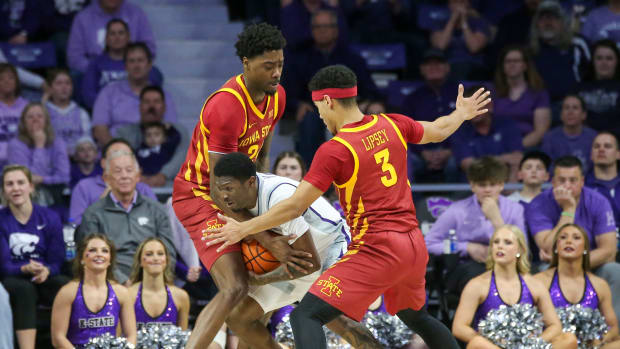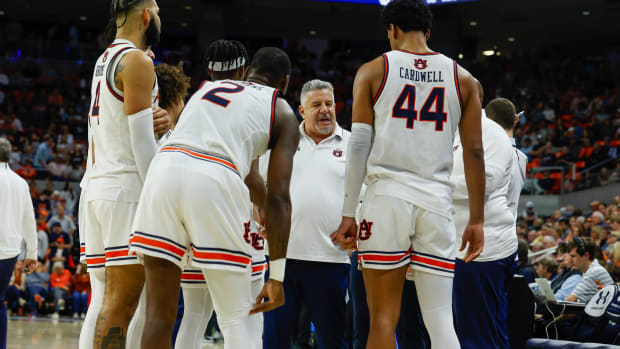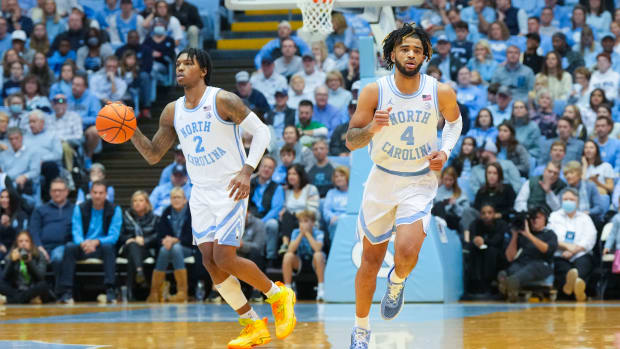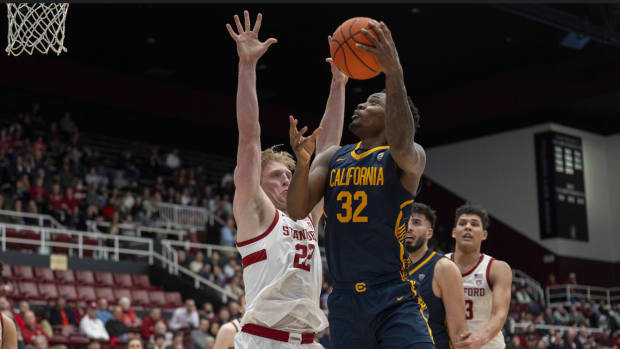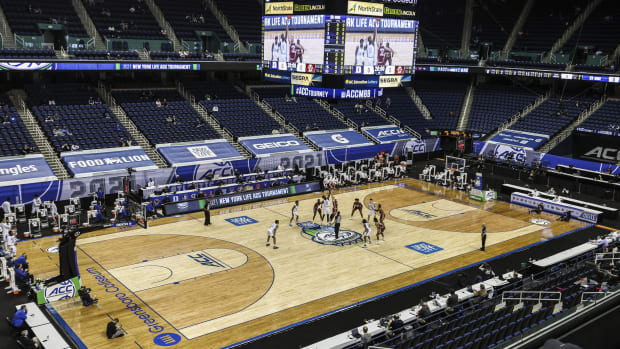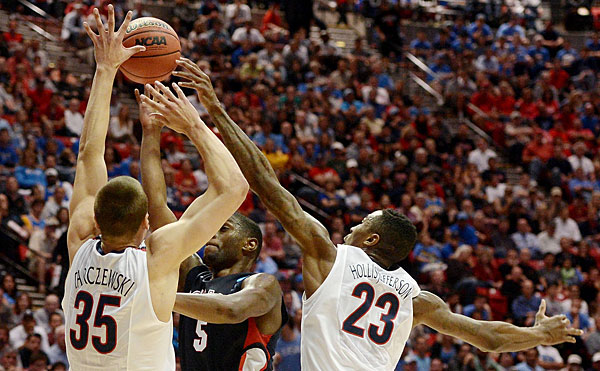
Five winners (Kentucky, Lousville) and five losers (Michigan, UCLA) from NBA draft decisions
Kaleb Tarczewski and Rondae Hollis-Jefferson will be back to help Arizona stay among the elite teams in the nation. (Donald Miralle/Getty Images)
The deadline for college basketball players to declare for the NBA draft came and went Sunday. Rosters for next season won't be fixed for some time – the robust transfer market and a few late-signing high school players will affect those significantly – but it's clear that some teams emerged from the stay-or-go uncertainty in better shape than others.
Here's an alphabetical look at the top winners and losers of the NBA draft decisions season.
Winners
Arizona Wildcats
This seems counterintuitive, given that the best defense in the country lost two of the best defenders on it, with Aaron Gordon (3.3 defensive win shares, best in the nation) and Nick Johnson (3.0 defensive win shares, 11th nationally) leaving for the NBA draft. It's easy to focus on what the Wildcats lost, however, especially given that Johnson, an All-America, is a tweener guard who could have returned and probably would've been drafted in the same spot in 2015 as he will be this year. But centers Brandon Ashley (11.5 points, 5.8 rebounds per game) and Kaleb Tarczewski (9.9 points per game) and forward Rondae Hollis-Jefferson (9.1) all announced they would come back to Tucson. That trio will combine with point guard T.J. McConnell and top five recruit Stanley Johnson to keep Arizona among the top contenders next season.
Connecticut Huskies
With a pair of 20-point, 10-rebound games during the NCAA tournament, DeAndre Daniels demonstrated how good he could be in certain games. Here's what he was for the entirety of 2013-14: A forward who averaged 13.1 points and six rebounds per night, numbers that don't exactly leap off the screen. Sure, if Daniels had returned and played like the dynamic force he often was in the postseason, then the Huskies lost something significant. Otherwise, they lost production that can be replicated somewhat by a player like Amida Brimah getting a year older and a year better.
More importantly, Ryan Boatright turned down dicey draft positioning in favor of attempting to be the next Kemba Walker or Shabazz Napier – a dominant upperclassman guard who leads Connecticut to a championship. Boatright can be the glue as the Huskies add new parts to the backcourt like transfer Rodney Purvis, junior college signee Sam Cassell, Jr. and five-star swingman Daniel Hamilton. Having Boatright's defense and unquestioned leadership to lean on is a windfall for head coach Kevin Ollie.
Kentucky Wildcats
A program unapologetically built on transients will be a national title contender again because of players who decided to stay put. Julius Randle and James Young, the team's top two scorers last season, both declared for the NBA draft, as expected, but the Wildcats then benefitted tremendously from every other coin-toss decision coming up “Lexington.” Willie Cauley-Stein, Dakari Johnson and Alex Poythress elected to return and bolster a gargantuan frontcourt that adds top 15 recruits Trey Lyles and Karl Towns as well. (Cauley-Stein, Johnson and Poythress combined for 17.9 points and 14.5 rebounds a night last year.) Most critically, guards Aaron and Andrew Harrison announced their joint decision to stay last Friday, reloading the backcourt with experience (the pair logged 2,570 minutes and started 79 games combined as freshmen) and thereby eliminating the one potential question area Kentucky faced for 2013-14.
Louisville Cardinals
One of the earlier draft decisions was among the most stunning. Forward Montrezl Harrell announced one week after the national title game that he would return for his junior season with the Cardinals, and instantly, Rick Pitino had a top 10-caliber roster. Harrell, a 6-foot-8, 235-pound forward, is riding a steep upward trajectory after averaging 14 points and 8.4 rebounds with 49 blocked shots as a sophomore, while ranking sixth nationally in field goal percentage (60.9 percent). Louisville now has experience in the backcourt with rising senior Chris Jones, on the wing with rising senior Wayne Blackshear and in the paint with Harrell, a returning captain. It also has the No. 7 recruiting class nationally, per Rivals.com, to provide reinforcements. Harrell ensured the program's first ACC season will be one in which the Cardinals are among the nation's best teams.
Wisconsin Badgers
In tear-filled locker room following the loss to Kentucky at the Final Four, both Sam Dekker and Frank Kaminsky declared they would return for their junior and senior seasons, respectively. It was just a matter of waiting to see if the emotions of the moment were overridden by further examination of their NBA prospects. That didn't happen, and as a result, the Badgers will return a team possibly even better than the version that won 30 games in 2013-14. Kaminsky (13.9 points per game) and Dekker (12.4) can both get better, of course. The former needs to become more consistent (he had two games with 28 points and one with 43, but also had two games with just two points) and the latter needs to improve his perimeter shooting (just 32.6 percent from three). They will combine with rising sophomore Nigel Hayes, the Big Ten's sixth man of the year, to form a versatile frontcourt that is nearly impossible to limit on the offensive end.
Losers
Michigan Wolverines
When leading scorers Nik Stauskas and Glenn Robinson III vacated the premises, it was hardly a surprise. The future for Mitch McGary, a preseason All-America who was coming off January back surgery, was less clear until a failed NCAA-administered drug test made the decision for him. Facing a one-year suspension after testing positive for marijuana use during the NCAA tournament, McGary announced last week that he would head to the NBA. Michigan had Caris LeVert and role players like Derrick Walton and Zak Irvin on hand to compensate on the wings for Stauskas and Robinson III, but there is no one on the roster who can match the potential that a star forward like McGary offered. He would have anchored the paint while LeVert led from the perimeter. Now the Wolverines will scramble to assimilate unproven pieces and likely will struggle to keep pace with Wisconsin in the Big Ten.
Missouri Tigers
As the season wore on, it became clear that Jabari Brown and Jordan Clarkson might move along to the next level. Brown averaged 19.9 points per game and Clarkson added 17.5 per night for the Tigers, though Clarkson's shooting dipped significantly toward the end of the regular season (seven straight games with less than 50 percent efficiency from the floor). Both, though, are projected as second-round picks by DraftExpress, meaning they could have improved their stock with another season on campus. They also left Missouri in the lurch. Along with the graduation of Earnest Ross, the Tigers have now lost their three top scorers and their leading returning scorer, rising sophomore Johnathan Williams III, averaged just 5.8 points per game as a freshman. Oh, and there's a new coach coming in, too, after Frank Haith bolted for Tulsa. Whoever it is will have his work cut out for him.
Syracuse Orange
Tyler Ennis' often superlative freshman season (12.9 points, 5.5 assists, 2.1 steals per game) trailed off at the end, but he remained among the top point guards on most draft boards, making his decision to go an easy one. Jerami Grant's sophomore season demonstrated enough production (12.1 points, 6.8 rebounds) to match the promise his 6-foot-8, 210-pound frame offered. After they left, the Orange's roster is loaded only with questions, with three of its four double-digit scorers gone. (C.J. Fair graduated.) Jim Boeheim will have to lean on top recruits Chris McCullough and Kaleb Joseph immediately in an arduous ACC.
UCLA Bruins
The Bruins suffered in most agonizing fashion. Kyle Anderson's move to the NBA was expected for months, ever since his father established that as the intent before the season began. Zach LaVine's jump became increasingly anticipated as well, even though his 9.4 points per game made it a bit nonsensical. Most grievous was the stay-then-go flip by leading scorer Jordan Adams. The 6-foot-4 guard announced he would return, giving UCLA a go-to player for next season. On Saturday, he changed his mind, and that changed the Bruins' fortunes. Steve Alford went from knowing exactly where to start as he builds his 2014-15 team to just about starting from scratch.
UNLV Runnin' Rebels
It's not that the Rebels have no talent to fall back on after Roscoe Smith and Khem Birch declared for the draft. It's that UNLV could have been much, much better if either had elected to stay. Smith (11.1 points, 10.9 rebounds per game) was a goner early on, but Birch took his time before deciding to take his 11.5 points, 10.2 rebounds and 3.8 blocks to the pros. UNLV did bring in some serious freshman perimeter talent. Shooting guard Rashad Vaughn and swingman Dwayne Morgan are both five-star recruits, and with Birch, the Runnin' Rebels might have had an inside-outside combo that was among the best in the West.
It's A Draw
Duke Blue Devils and Kansas Jayhawks
Rasheed Sulaimon
Wayne Selden, Jr.
Perry Ellis
and

